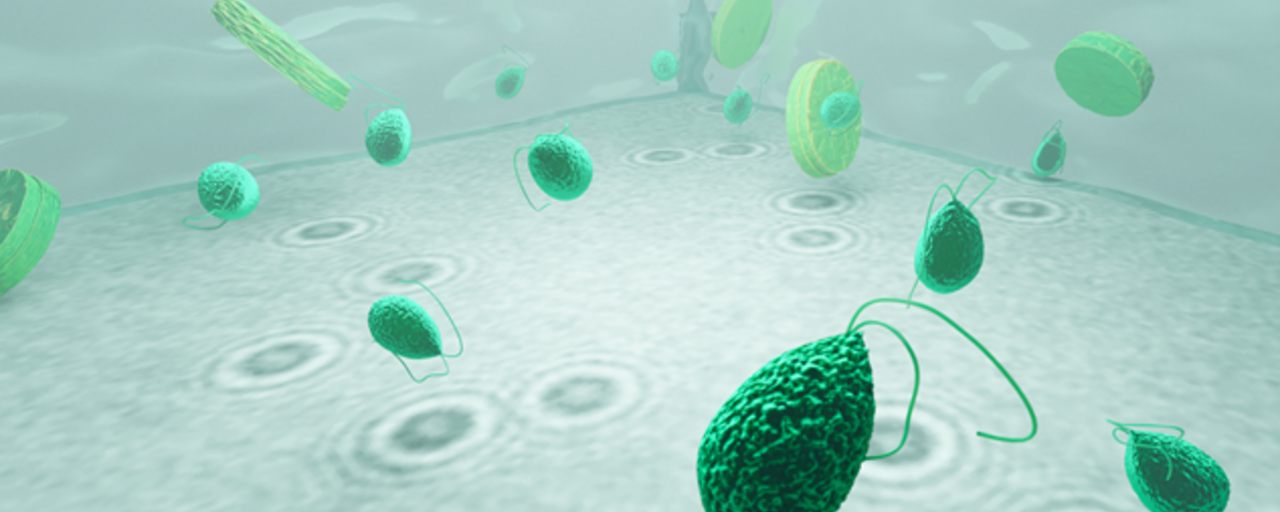For the first time, scientists can now watch the lives of microplankton at the individual level utilizing holograms produced in digital microscopes and processed by artificial intelligence (AI). A collaborative research study at the University of Gothenburg developed the approach.
 An illustration of microplankton in a solution. The round rings under the microplankton are the holograms formed when light is refracted by the microplankton. Image Credit: University of Gothenburg.
An illustration of microplankton in a solution. The round rings under the microplankton are the holograms formed when light is refracted by the microplankton. Image Credit: University of Gothenburg.
One of the most significant organisms on Earth is plankton. Phytoplankton in the oceans produces more than half of the oxygen in the world. But because of their small size, very little is known about these life forms.
Until now I had to study microplankton at the group level, but thanks to this new AI based holographic microscope I can see how individual microplanktons move, eat, grow and reproduce.”
Erik Selander, Marine Biologist, University of Gothenburg
The only way to study microplankton at the individual level
Erik Selander heard Giovanni Volpe, Professor of Physics at the University, lecture about a new approach in which light refracted through a particle generates a hologram that can be analyzed instead of the particle at a conference in 2019. The holograms may be analyzed at much quicker speeds using AI, delivering more and sharper details. Selander and Volpe then began an interdisciplinary effort focused on microplankton.
We have a good understanding of who eats who, and where they go in the case of larger organisms such as animals and birds that we see every day. The method we have developed is the only one that works to study microscopic organisms at the individual level.”
Giovanni Volpe, Professor, Physics, University of Gothenburg
AI makes the method much faster
The method analyzes microplankton in holographic microscopes using LED light, which assures that the organisms are not affected throughout the procedure. This discovery was revealed in a paper published in the journal eLife.
Erik Selander details, “The microplankton cells we examine are only a few hundredths of a millimeter in size. But they are so numerous that they affect the entire carbon cycle of the ocean. In total, single cell microplankton take up about three times as much carbon as we humans emit from fossil fuels. Now we are able to get a detailed understanding of these processes at the individual level.”
The approach of recording light-matter interaction using digital cameras and a holographic microscope has already been widely investigated. However, thanks to digital technology and the recent AI revolution, this method is significantly more useful, and analysis is a lot quicker and faster.
By combining holographic microscopy with AI, now we can simultaneously monitor what is happening with a large collection of microplankton cells at a single cell-level, which was a challenge before. Though the technique is demonstrated with marine microorganisms, it is quite universal in approach and can be applied to any microscopic lifeform. And by enclosing the cells in miniatured glass wells, we can follow the growth dynamics and swimming behaviors of cells, throughout their life cycle from hours to days.”
Harshith Bachimanchi, Doctoral Student, Physics, University of Gothenburg
Holographic microscopy is also a quick and economical way to count, weigh, and size cells or other particles in a solution.
Source:
Journal reference:
Bachimanchi, H., et al. (2022) Microplankton life histories revealed by holographic microscopy and deep learning. eLife. doi.org/10.7554/eLife.79760.